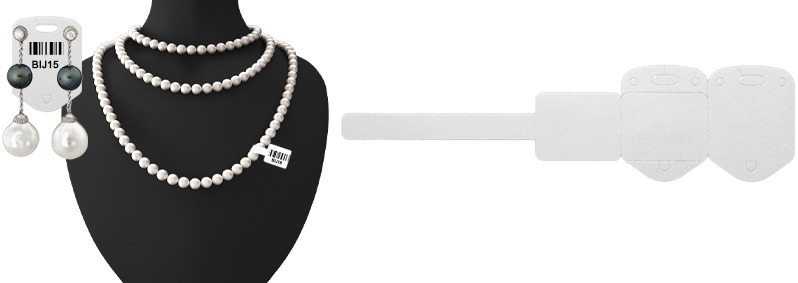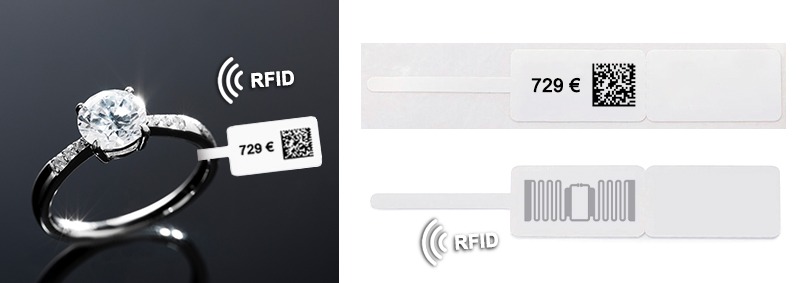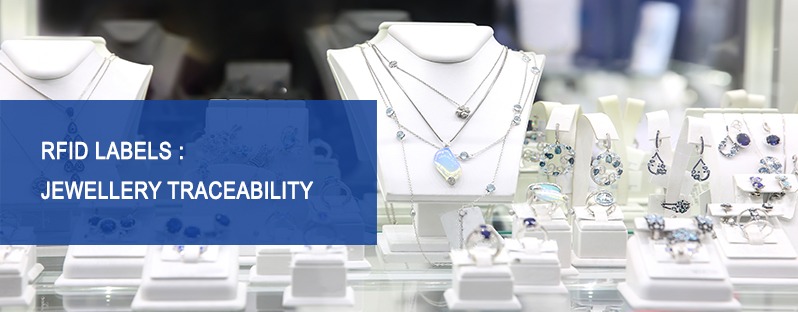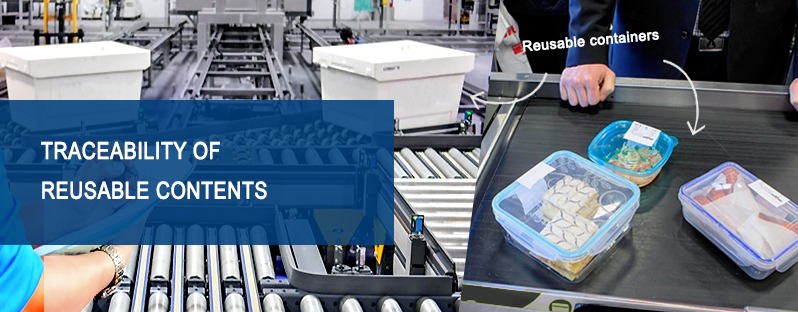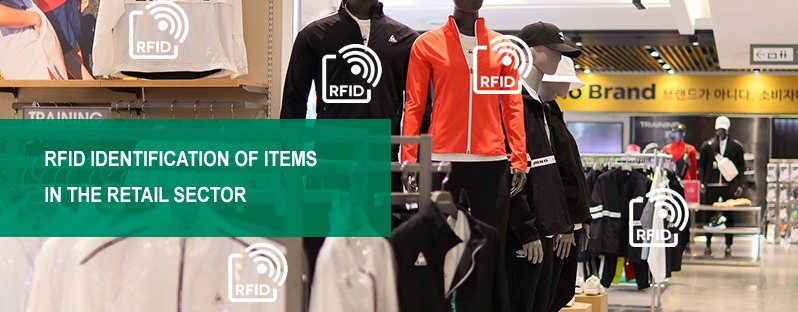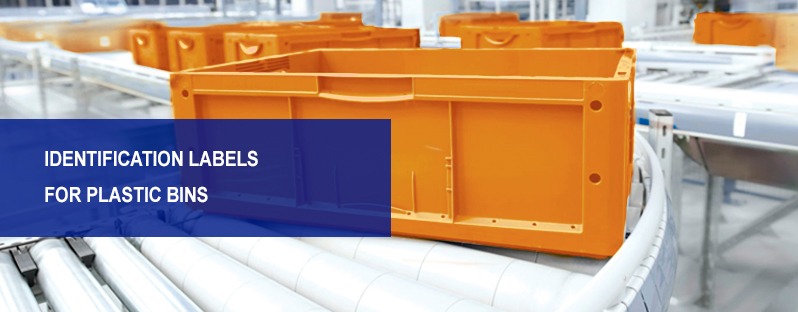Identifying jewellery with RFID: optimising inventory!
Tired of spending hours counting your products? Want to save time, improve efficiency and exactness, and avoid any risk of error? Switch to RFID!
RFID is a technology that uses radio waves to identify and track objects at a distance. Today, this technology is used to identify and track jewellery. RFID makes it easy to do a stock inventory of your jewellery!
Etik Ouest is a French manufacturer, technical and RFID labels expert, offering solutions suitable to the jewellery sector. Discover our standard labels and RFID jewellery labels!
Standard jewellery label: easy and effective identification
Jewellery is a small, precious product that needs to be handled delicately and meticulously, and is usually displayed in large quantities.
Customized labelling makes it easier to show them off to their best advantage and to identify them immediately without having to open the display case. Standard labels are used to indicate a reference or a price. They are discreet and designed not to get in the way when trying on jewellery.
Your logo can be pre-printed in color. The labels can then be customized according to the information you wish to add.
Standard jewellery label with a made to measure customization
Etik Ouest makes standard jewellery labels, not made-to-measure ones, available in printable versions, on rolls or even as folding screens.
If you want to print your own labels, we can adapt the number of labels per roll to suit to your printing machine, and can suggest the most suitable thermal transfer film adapted to your equipment and advise for the material making up your label.
We can make tailor-made cut-outs for labels to suit to specific products, or offer you a multi-purpose jewellery label that can be used for earrings, rings, necklaces or bracelets.
You can also choose whether you want a paper or synthetic label, glossy or matt, adhesive or non-adhesive. If you choose an adhesive label but do not want it to stick to the labelled jewellery, we can neutralize the adhesive with a non-adhesive synthetic or a varnish applied to one or more defined areas.
We also work with you to find the most suitable adhesive material for your project, and if adhesion to the jewellery is not a constraint, we can study the presence or absence of residue as the label is removed, using the different adhesives, we have as standard: acrylic or rubber-based, permanent or removable. Depending on your requirements, we can select the thickness of your product: some products are even tear-proof!
Multi-purpose label: the label can be used to identify a necklace, bracelet, ring or watch but also for earings.
To sum up, Etik Ouest manufactures your standard made-to-measure jewellery labels and adapted to all your needs. The company also offers small, discreet RFID tags that can be used to identify, track, authenticate and manage your jewellery stocks.
RFID labels: advantages
Unlike barcodes, RFID can be read and rewritten a large number of times, with a code that is difficult to reproduce. Depending on the integrated chips, you can also consider locking the writing once the encoding has been realized. This ensures that the data will last once the RFID tags are on the market.
RFID tags offer a number of advantages. Several RFID tags can be read simultaneously from a distance, enabling information to be gathered quickly and accurately.
RFID jewellery tags make stocktaking much easier: using a fixed or portable reader, you can instantly read the items in your proximity.
As a result, you save time, improve traceability and eliminate the risk of errors.
Personal technical support for your RFID jewellery labels
RFID is a reliable, efficient, high-performance technology that provides security.
Depending on the amount of information to be stored in your label, we select an inlay and a chip with the ideal memory capacity. The format of your labels is defined according to your space constraints and the antenna chosen. We can now offer you printable mini RFID labels in 17×13 mm format.
We can help you personalize your RFID tag, including encoding and printing. All you need to do is to let us know the serial number you want, and we make sure there are no duplicates for all your future orders.
RFID jewellery labels functioning
UHF, NFC or HF: which frequency should you choose?
The jewellery sector favors Ultra High Frequency (UHF). This is a specific RFID (Radio Frequency Identification) protocol that enables mass reading from a variable distance. This can fluctuate between a few centimeters and several meters. It depends on the size of the antenna, the associated chip, the reader and the reading conditions. Its communication frequency varies between 868 and 915 MHz in Europe. In very specific applications and when combined with suitable antennae, UHF acts as an anti-theft device, saving retailers from having to invest in 8.2 MHz anti-theft devices. So the same RFID tag can be used for logistics, product traceability, stock management and potentially cash collection and fraud protection!
HF (High Frequency) and NFC (Near Field Communication) technologies apply to near-field reading. The major difference between these two technologies, which share the same frequency (13.56 MHz), is the protocol used: 15693 for HF and 14443 for NFC. Put simply, NFC is used with smartphones and provides access to a website via an encoded URL, for example. This technology is used for consumer and customer experience. HF, on the other hand, is used for internal reading in industry.
In these three cases, RFID is described as passive because the inlays (chip and antenna pair) do not emit waves without being activated. The antenna receives energy from the reader and transmits it to the chip. The chip then sends the stored data back to the reader, where it can be consulted by the user.
RFID, wave traffic
Two parameters complicate the circulation of waves, whatever the frequency used. These are liquids and metals. If the inlay antenna, often made of aluminium or copper, is applied directly to metal, the wave is unable to be differentiated between the antenna and the substrate: feedback is not possible and reading does not work. Similarly, liquids affect the waves through refraction and reflection. The user cannot read the information contained in the tag if it is applied directly on a product containing liquid. For these two particular applications, there are tags specifically developed to be read on metal or liquid. Etik Ouest is at your disposal to find a technical solution for your project, tailor-made for you!
Etik Ouest, made-to-measure quality products
To sum up, the use of jewellery labels varies according to the practices of manufacturers or jewellery experts. Some labels can be standard and others more technical with RFID. In all cases, Etik Ouest offers you custom-made labels that are sure to meet your specifications. Are you looking for a label supplier that combines agility, reliability and quality? Consult us!
